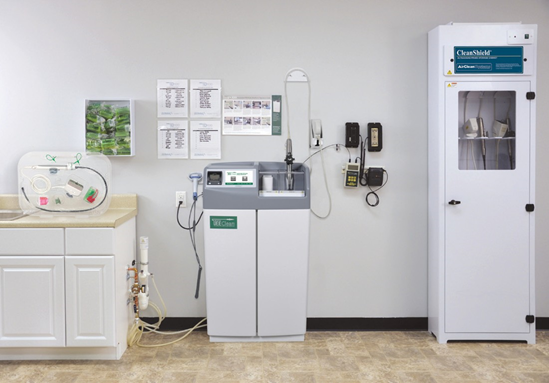COVID-19 and Pathogen Transmission by Transesophageal Echocardiogram Probes
Author: Thomas H. Fischer, Ph.D., Chief Science Officer, CS Medical, LLC, Creedmoor, NC
Introduction
Abstract: Transesophageal echocardiography (TEE) is proving to be a valuable tool for assessing cardiac function of ICU patients with COVID-19 disease, including those on ventilators. However, the use of TEE probes with COVID-19 patients leads to additional risk with regards to providing reliable high-level disinfection in the reprocessing of TEE probes. The additional risks originate from two factors: the increased probability of a pathogenic organism being on the TEE probe (a "biological factor") and failure to carefully follow institutional guidelines for performing high-level disinfection procedures if ICU staff is overburdened with COVID-19 patients (a "human factor"). The analysis presented here points towards automated single-use disinfection as a reprocessing method for TEE probes that largely ameliorates the excess risks of COVID-19 virus transmission.
COVID-19 virus represents a new "biological factor" which challenges the overall effectiveness of high-level disinfection processes. This is a very relevant concern given the widely appreciated connection between COVI D-19 disease severity and cardiac diseases, and the fact that TEE is proving a valuable method for assessing the cardiac status of severely-affected COVI D-19 patients. There is thus increased risk of pathogen contamination of TEE probes. The overall risk of disinfection failure goes up because the risks of COVID-19 virus contamination (a biological factor) increases.
While COVID-19 is an enveloped virus that is structurally similar to other test viruses that are readily inactivated by high level disinfectants, the efficacy of disinfectants toward the new pathogen are not validated or standardized. As a single strand RNA bilayer membrane enveloped virus, COVID-19 is closely related to the MERS-CoV and SARS-CoV viruses. COVI D-19 is structurally similar to hepatitis C, HIV and Influenza A, the latter of which is a recommended test virus for FDA clearance as a high-level disinfectant. Based on similarities with Influenza A, FDA cleared high-level disinfectants should inactivate COVID-19. However, the efficacy of disinfectants toward the new pathogen are not validated or standardized. The important point is that in the event that high-level disinfection chemistry fails (e.g., due to materials defects, biofilm formation, or poor pre-disinfection probe cleaning), the probability that the contaminating microorganism is pathogenic is increased with COVI D-19.

Chemical and human factors do not remain constant in the face of COVI D-19 as a biological risk factor. The COVI D-19 pandemic creates human factor challenges that can affect the efficacy of high-level disinfections. For example, is a stressed healthcare provider going to pay proper attention to the details of TEE probe cleaning before disinfection? Personnel distractions in ICUs that are challenged with COVID-19 patients can lead to failures to fully apply institutional guidelines related to high-level disinfection. Per regulations medical devices must be properly cleaned in order to be properly disinfected. If the probe has remaining soil or biological factors remaining on it after cleaning, it cannot be properly disinfected and puts the next patient at risk. Thus making it critical to ensure the cleaning process is done following rigorous manufacturer's instructions. Therefore using an automated cleaner removes the potential for human error.
TEE probes are disinfected with either highly labor intensive manual methods or with specialized automated disinfectors (reprocessors). With either manual or automated disinfection, the disinfection step where the probe is exposed to disinfectant is carried out two ways: disinfectant single-use or re-use. With disinfectant single-use, fresh disinfectant is provided for each TEE probe reprocessing, and then discarded. In contrast, with re-use a "pool" of disinfectant is utilized multiple times as different soiled probes are disinfected over a period of days; the chemistry is not as reliable as with single-use and extra complexity is introduced because of the need to validate the potency of the disinfectant pool with a chemical indicator between each use. The complexities involved with disinfectant re-use are potential stress factors for healthcare providers that perform high level disinfection procedures. The result is increased risk of failure related to human error and/or related chemistry failure. Single use disinfectant also reduces the risk of having any residual biological matter carried over from inadequately cleaned devices into the next disinfection cycle as it would be with reusable disinfectants, which in return could cause potentially unknown factors.

Automated, single-use disinfection reduces potential human elements for process failure, and provides a more reliable (consistent) disinfection chemistry. This is particularly true if the automated disinfection stage is preceded by an automated cleaning stage. We therefore recommend the single-use of disinfectants in automated reprocessors with cleaning stages as a strategy of reducing pathogen reduction risks related to COVID-19 virus.
About the author: Dr. Fischer is an expert in mechanisms of disease processes. He holds a Ph. D. in Biophysics form Florida State University, has spent 30 years as a faculty member at the University of North Carolina at Chapel Hill in medical research, and has been involved as a company founder and inventor of medical devices and therapeutics in the private sector. Dr. Fischer is currently the Chief Science Officer of CS Medical, LLC.
